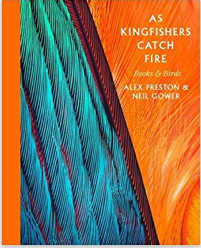In a review-article of As Kingfishers Catch Fire: Books and Birds by Alex Preston and Neal Gower that was recently published in the Financial Times (subscription required), John Updike merits a mention:
 “The book is in 21 short sections, each based on a single species and the varying inspirations it has brought for previous authors, Ted Hughes, Mary Oliver and Kathleen Jamie to the fore, and, through them, for Preston himself. The style seems fey at first and the self-referencing somewhat clumsy, but the form is potent.
“The book is in 21 short sections, each based on a single species and the varying inspirations it has brought for previous authors, Ted Hughes, Mary Oliver and Kathleen Jamie to the fore, and, through them, for Preston himself. The style seems fey at first and the self-referencing somewhat clumsy, but the form is potent.
“Each section, from Peregrine to Peacock, Robin to Wren, is illustrated by the artist, Neil Gower. These pictures, most intensely of Swift (above right) and Waxwing, are alone worth the price of a book beautifully presented in matt orange cloth. A blue sky full of gulls introduces a poem by John Updike where the birds ‘stand around in the dimpled sand like those melancholy European crowds that gather in cobbled public squares in the wake of assassinations and invasions, heads cocked to hear the latest radio reports.’ After the terrorist strike on London Bridge, we who were working nearby saw countless such gulls on the sands of the Thames and Preston, through Updike, reminds us that we did.
“Birds, more than mammals or fish, are the great reminders in literary history. An individual sight or song of a bird means most by bringing back the last time of seeing or hearing. Gulls gain added force for poets because they were for centuries the sole companions of sailors, the only life for men to observe in so much air and their only sharer of it.
“Those white clouds over trash pits today were once almost humans. Preston notes Updike’s glowing seaside conclusion in which ‘plump young couples . . . walk capricious paths through the scattering gulls, as in some mythologies beautiful gods stroll unconcerned among our mortal apprehensions.'”
